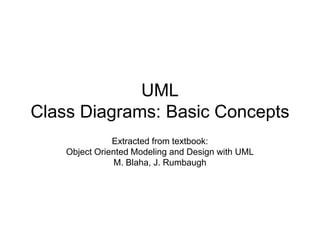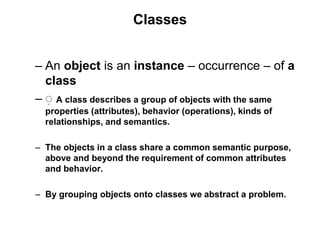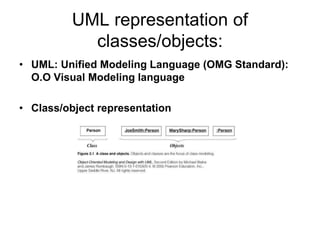cse 355 UML class diagram software engineering.ppt
- 1. UML Class Diagrams: Basic Concepts Extracted from textbook: Object Oriented Modeling and Design with UML M. Blaha, J. Rumbaugh
- 2. Objects – The purpose of class modeling is to describe objects. – An object is a concept, abstraction or thing that has meaning for a domain/application. – Some objects have real world counterparts while others are conceptual entities. – The choice of objects depends on judgment and the nature of problem. – ِAll objects have identity and are distinguishable.
- 3. Classes – An object is an instance – occurrence – of a class – ِ A class describes a group of objects with the same properties (attributes), behavior (operations), kinds of relationships, and semantics. – The objects in a class share a common semantic purpose, above and beyond the requirement of common attributes and behavior. – By grouping objects onto classes we abstract a problem.
- 4. UML representation of classes/objects: • UML: Unified Modeling Language (OMG Standard): O.O Visual Modeling language • Class/object representation
- 5. Values and attributes • Value : piece of data. • Attribute: a named property of a class that describes a value held by each object of the class. – Attributes may be discovered by looking for adjectives or by abstracting typical values. – Don’t confuse values with objects: • An attribute should describe values, not objects. • Unlike objects, values lac identity
- 7. Object identifiers • Objects identifiers are implicit. • Objects belonging to the same and having the same attributes values may be different individual objects.
- 8. Operations and Methods • An operation is a function or procedure that may be applied to or by objects in a class. • Each operation has a target object as an implicit parameter. • All objects in a class share the same operations. • The behavior of the operation depends on the class of its target. • The same operation may apply to many different classes. Such an operation is POLYMORPHIC.
- 9. Operations and Methods • A method is the implementation of an operation for a class. • A different piece of code may implement each method. • An operation may have arguments in addition to its target object. These arguments may be placeholders for values and/or for objects. • When an operation has methods on several classes these methods must have the same SIGNATURE: number and types of arguments, type of result value.
- 11. Links and Association concepts • A link is a physical or conceptual connection among objects. • Most links relate two objects, but some links relate three or more objects. • A link is defined as a tuple, that is a list of objects. • A link is an instance of an association. • An association is a description of a group of links with common structure and semantics. • Association is denoted by a line. Its name is optional if the model is unambigious.
- 12. Examples
- 13. • Associations are inherently bi-directional. The association name is usually read in a particular direction but the binary association may be traversed in either direction. • ِ A reference is an attribute in one object that refers to another object.
- 14. Multiplicity • It specifies the number of instances of one class that may relate to a single instance of the associated class. • UML diagrams explicitly list multiplicity at the end of association lines. • Intervals are used to express multiplicity: – 1 (exactly one) – 0..1 (zero or one) – 1..* (one or more) – 0..* (zero or more) – 3..5 (three to five inclusive)
- 15. Association Ends • Associations have ends. They are called ‘Association Ends’. • They may have names (which often appear in problem descriptions).
- 16. Association Ends • Use of association end names is optional. • But association end names are useful for traversing associations. • ِAssociation end names are necessary for for associations between objects of the same class.
- 17. Example of association ends use
- 18. Association: ordering, bag, sequence • On a ‘many” association end, sometimes, it is required that objects have an explicit order. • In this case the ordering is an inherent part of the association • Example:
- 19. Association: ordering, bag, sequence • Ordinary a binary association has at most one link for a pair of objects • However we can permit multiple links for a pair of objects by annotating an association end with {bag} or {sequence} • A bag is a collection of elements with duplicates allowed. • A sequence is an ordered collection of elements with duplicates allowed
- 20. Association class • UML offers the ability to describe links of association with attributes like any class. • An association class is an association that is also a class.
- 23. Qualified Association • A qualified association is an association in which an attribute called Qualifier disambiguates the objects for a ‘many’ association’ end. • A qualifier selects among the target objects, reducing the effective multiplicity fro ‘many’ to ‘one’. • Both below models are acceptable but the qualified model adds information.
- 25. Generalization/Inheritance • Generalization is the relationship between a class (superclass) and one or more variations of the class (subclasses). • Generalization organizes classes by their similarities and their differences, structuring the descriptions of objects. • A superclass holds common attributes, attributes and associations. • The subclasses adds specific attributes, operations, and associations. They inherit the features of their superclass. • Often Generalization is called a “IS A” relationship • Simple generalization organizes classes into a hierarchy. • A subclass may override a superclass feature (attribute default values, operation) by redefining a feature with the same name. • Never override the signature of methods.
- 27. Use of generalization • Used for three purposes: – Support of polymorphism: • polymorphism increases the flexibility of software. • Adding a new subclass and automatically inheriting superclass behavior. – Structuring the description of objects: • Forming a taxonomy (classification), organizing objects according to their similarities. It is much more profound than modeling each class individually and in isolation of other similar classes. – Enabling code reuse: • Reuse is more productive than repeatedly writing code from scratch.
- 28. Aggregation • Aggregation is a strong form of association in which an aggregate object is made of constituent parts. • The aggregate is semantically an extended object that is treated as a UNIT in many operations, although physically it is made of several lesser objects. • Aggregation is a transitive relation: – if A is a part od B and B is a part of C then A is also a part of C • Aggregation is an antisymmetric relation: – If A is a part of B then B is not a part of A.
- 30. Aggregation versus Association • Aggregation is a special form of association, not an independent concept. • Aggregation adds semantic connotations: – If two objects are tightly bound by a part-whole relation it is an aggregation. – If the two objects are usually considered as independent, even though they may often be linked, it is an association. • Discovering aggregation – Would you use the phrase part of ? – Do some operations on the whole automatically apply to its parts? – Do some attributes values propagates from the whole to all or some parts? – Is there an asymmetry to the association, where one class is subordinate to the other?
- 31. Aggregation versus Composition • Composition is a form of aggregation with additional constraints: – A constituent part can belong to at most one assembly (whole). • it has a coincident lifetime with the assembly. • Deletion of an assembly object triggers automatically a deletion of all constituent objects via composition. – Composition implies ownership of the parts by the whole. • Parts cannot be shared by different wholes.
- 32. Aggregation versus Composition Composition is a strong form of aggregation where: • Deletion of a “whole” triggers automatically deletion of all its “parts”. (Lifetime) • “Parts” are included in at most one “whole” at a time. (Sharing)
- 34. Propagation of operations • Propagation is the automatic application of an operation to a network of objects when the operation is applied to some starting object. • Propagation of operations to parts is often a good indicator of propagation.


































